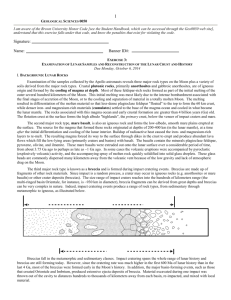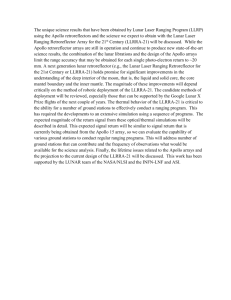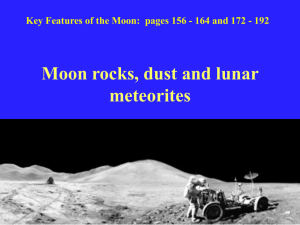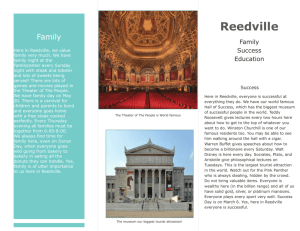GEOLOGICAL SCIENCES 0050 - Brown University Planetary
advertisement
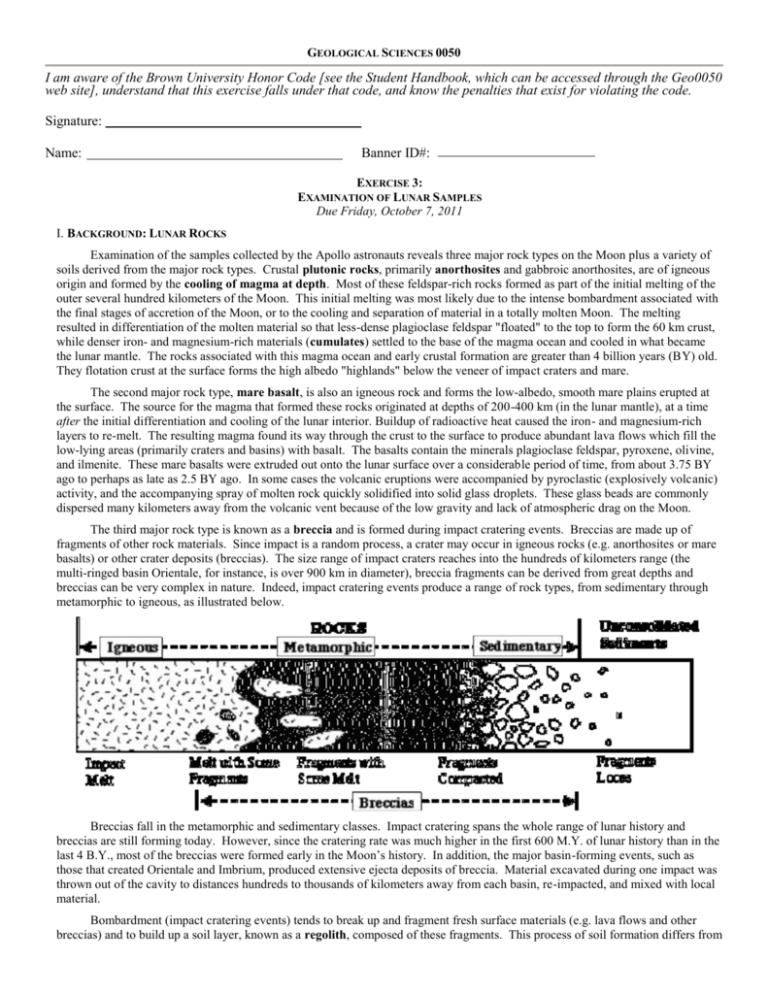
GEOLOGICAL SCIENCES 0050 I am aware of the Brown University Honor Code [see the Student Handbook, which can be accessed through the Geo0050 web site], understand that this exercise falls under that code, and know the penalties that exist for violating the code. Signature: Name: Banner ID#: EXERCISE 3: EXAMINATION OF LUNAR SAMPLES Due Friday, October 7, 2011 I. BACKGROUND: LUNAR ROCKS Examination of the samples collected by the Apollo astronauts reveals three major rock types on the Moon plus a variety of soils derived from the major rock types. Crustal plutonic rocks, primarily anorthosites and gabbroic anorthosites, are of igneous origin and formed by the cooling of magma at depth. Most of these feldspar-rich rocks formed as part of the initial melting of the outer several hundred kilometers of the Moon. This initial melting was most likely due to the intense bombardment associated with the final stages of accretion of the Moon, or to the cooling and separation of material in a totally molten Moon. The melting resulted in differentiation of the molten material so that less-dense plagioclase feldspar "floated" to the top to form the 60 km crust, while denser iron- and magnesium-rich materials (cumulates) settled to the base of the magma ocean and cooled in what became the lunar mantle. The rocks associated with this magma ocean and early crustal formation are greater than 4 billion years (BY) old. They flotation crust at the surface forms the high albedo "highlands" below the veneer of impact craters and mare. The second major rock type, mare basalt, is also an igneous rock and forms the low-albedo, smooth mare plains erupted at the surface. The source for the magma that formed these rocks originated at depths of 200-400 km (in the lunar mantle), at a time after the initial differentiation and cooling of the lunar interior. Buildup of radioactive heat caused the iron- and magnesium-rich layers to re-melt. The resulting magma found its way through the crust to the surface to produce abundant lava flows which fill the low-lying areas (primarily craters and basins) with basalt. The basalts contain the minerals plagioclase feldspar, pyroxene, olivine, and ilmenite. These mare basalts were extruded out onto the lunar surface over a considerable period of time, from about 3.75 BY ago to perhaps as late as 2.5 BY ago. In some cases the volcanic eruptions were accompanied by pyroclastic (explosively volcanic) activity, and the accompanying spray of molten rock quickly solidified into solid glass droplets. These glass beads are commonly dispersed many kilometers away from the volcanic vent because of the low gravity and lack of atmospheric drag on the Moon. The third major rock type is known as a breccia and is formed during impact cratering events. Breccias are made up of fragments of other rock materials. Since impact is a random process, a crater may occur in igneous rocks (e.g. anorthosites or mare basalts) or other crater deposits (breccias). The size range of impact craters reaches into the hundreds of kilometers range (the multi-ringed basin Orientale, for instance, is over 900 km in diameter), breccia fragments can be derived from great depths and breccias can be very complex in nature. Indeed, impact cratering events produce a range of rock types, from sedimentary through metamorphic to igneous, as illustrated below. Breccias fall in the metamorphic and sedimentary classes. Impact cratering spans the whole range of lunar history and breccias are still forming today. However, since the cratering rate was much higher in the first 600 M.Y. of lunar history than in the last 4 B.Y., most of the breccias were formed early in the Moon’s history. In addition, the major basin-forming events, such as those that created Orientale and Imbrium, produced extensive ejecta deposits of breccia. Material excavated during one impact was thrown out of the cavity to distances hundreds to thousands of kilometers away from each basin, re-impacted, and mixed with local material. Bombardment (impact cratering events) tends to break up and fragment fresh surface materials (e.g. lava flows and other breccias) and to build up a soil layer, known as a regolith, composed of these fragments. This process of soil formation differs from the Earth in that there is an absence of chemical weathering (hydrolysis, leaching, etc.), biologically-induced weathering, and a dominance of mechanical weathering (physical breakdown). The lava flows at the Apollo 11 site were formed 3.7 BY ago, but basaltic samples picked up by Astronauts Armstrong and Aldrin appeared to be like any fresh terrestrial lava flow because they had not undergone chemical weathering. However, impact bombardment since their time of emplacement 3.7 BY ago had fragmented the original surface and produced a regolith or soil layer about seven meters thick! Analogously, the early, very heavy bombardment (first 600 MY) of the newly formed lunar crust produced a fragmental layer of enormous proportions (kilometers thick), which has been termed a megaregolith. II. EXAMINATION OF SAMPLES A. Plutonic Rocks Sample 60025 - Anorthosite This sample was collected by Apollo 16 astronauts John Young and Charlie Duke in the Descartes region (see photographs displayed during the laboratory exercise). It was found near a crater that excavated down into the lunar crust. It is a plutonic rock composed almost entirely (>95%) of crystals of plagioclase feldspar. Notice that the contacts between grains are not neat and interlocking as is typical of most igneous rocks. Rather, the boundaries show abundant signs of abrasion and fragmentation caused by movement between the grains. This is called cataclastic texture. The movement that caused the abrasion was almost certainly the result of the impact that excavated this sample from depth within the crust. This rock is over four billion years old! Things to look for: - plagioclase crystal fragments up to 4 mm. across - uniform composition (almost all one mineral) - cataclastic texture Technically, since this rock is fragmented, it could be called a breccia, but because it is composed largely of one rock type, it is called a cataclastic anorthosite. Sample 78235 - Norite This sample was collected by Astronauts Jack Schmitt and Gene Cernan at the base of the lunar highlands at the Apollo 17 site. The Apollo 17 site is at the southeastern edge of the Serenitatis basin, a large basin just east of Imbrium. Analysis of this rock indicates that it crystallized at depth within the Moon about 4.3 BY ago, cooling sufficiently slowly to develop large interlocking grains. Then it was excavated from the lunar interior by impact, probably by the event which created the Serenitatis basin about 4 billion years ago. The sample is coarse-grained (grains about 5 mm across) and composed of about 50% plagioclase and 50% orthopyroxene. Things to look for: - veinlets of brown glass - evidence of shock dating from when the sample was excavated B. Mare Basalts The lunar maria were sampled during Apollo 11, 12, 15, and 17 and Luna 16 and 24 (see the landing site location maps and the traverse maps of individual sites for more detail). Mare basalts contain the minerals plagioclase feldspar, pyroxene, olivine, and ilmenite, and a number of accessory minerals. A major chemical difference between basalts on the lunar surface is their Ti0 2 content (in the mineral ilmenite). Basalts from the Apollo 11 and 17 sites have Ti0 2 contents above ten percent, while basalts from other mare sites are between one and four percent. Sample 12002 - Mare Basalt (low TiO2) This sample was collected by Apollo 12 astronauts Al Bean and Pete Conrad just north of Head Crater in a portion of eastern Oceanus Procellarum known as Mare Cognitum. Things to look for: - plagioclase feldspar grains (elongate crystals, white and shades of gray with crossed nicols) - pyroxene & olivine (brilliant colors with crossed nicols) - freshness and crispness of minerals and boundaries The lava flow producing this basalt emerged onto the lunar surface 3.2 billion years ago, yet the basalts are some of the youngest yet sampled on the Moon! Sample 12005 is another somewhat similar mare basalt collected at the Apollo 12 site. Sample 70017 - Mare Basalt (high TiO2) This sample was collected by Apollo 17 Astronauts Gene Cernan and Jack Schmitt from the floor of the Taurus-Littrow Valley in the mountains adjacent to Mare Serenitatis (see photograph in lab). Things to look for: - plagioclase feldspar grains (elongate crystals, white and shades of gray with crossed nicols) - pyroxene & olivine (brilliant colors with crossed nicols) - ilmenite (TiO2) grains (opaque grains) These lavas were erupted onto the surface 3.7 billion years ago. They represent some of the earliest mare basalts, beginning the filling of the lunar basins (such as Serenitatis and Imbrium) only 100-300 million years after the basins formed. C. Breccias Sample 15299 - Polymict Breccia This sample was collected by Apollo 15 Astronauts Dave Scott and Jim Irwin at the base of the Apennine Mountains, the mountain range defining the edge of the Imbrium basin (see photograph). Polymict means that the breccia contains fragments of a variety of rock types. Things to look for: - matrix of very fine-grained material between clasts (particles of broken down rock/mineral) - mineral clasts (feldspar, pyroxene, olivine, ilmenite) - rock (lithic) clasts (breccias, basalts, plutonic rocks) This rock contains part of the ejecta from the Imbrium basin, but also contains some fragments of mare basalt. Since the mare basalt was emplaced after the basin was formed, the impact crater that formed the breccia must have occurred after the beginning of mare emplacement. Sample 14305 - Polymict Breccia This sample was collected during the Apollo 14 mission by Astronauts Alan Shepard and Ed Mitchell. Apollo 14 landed in the Fra Mauro Formation, a geologic unit comprised of a series of ridges radial to the Imbrium basin. On the basis of surface texture analogous to those surrounding smaller impact craters, this unit was interpreted as the ejecta deposit from the Imbrium basin (see photograph). The Apollo 14 site is hundreds of kilometers from the edge of the Imbium basin so we would expect ejecta transported to these distances to hit the ground with high velocity and to excavate additional material. Thus, the Fra Mauro Formation (Imbrium ejecta deposit) at this range or distance from the basin should consist of a mixture of material thrown out of the crater and local material excavated by the ejecta. Things to look for: - matrix - mineral clasts (plagioclase, pyroxene, ilmenite) are subrounded - lithic clasts are predominantly other breccias but a few basalts are present This rock formed at about 3.95 B.Y. ago, which is essentially the date of the Imbrium basin impact. The basalt clasts seen in these rocks are not the same as mare basalts. Since the clasts occur in the 3.95 billion year-old breccia, they must have formed prior to this time. Non-mare basalt clasts such as these are some of the primary evidence for pre-mare highland volcanism having occurred on the Moon. Sample 65015 - Polymict Breccia This sample was collected by Apollo 16 Astronauts Young and Duke in the Descartes region of the lunar highlands (see photograph). The rock was collected on the plains at the base of Stone Mountain (Station 5, see maps and photographs). Although it is in a region that shows radial texture from the Imbrium basin, it is so far from the basin rim that preexisting topography (mostly craters) is still very prominent. On the basis of our understanding of cratering processes, we would expect less Imbrium ejecta to reach these great distances. We would also expect whatever reached the region to impact at relatively high velocities (higher than at the Apollo 14 and 15 sites, for instance). The resulting surface deposits should then be dominated by materials from the underlying heavily cratered terrain. The Apollo 16 site lies within several old craters (see photograph) and deposits from these features appear to dominate the sample collection. Things to look for: - matrix is fine-grained, but crystalline, formed of tiny pyroxene and plagioclase crystals - mineral clasts include plagioclase, olivine, ilmenite - lithic clasts include: a. plutonic rocks (cataclastic anorthosites) b. other polymict breccias A very significant point is the crystalline nature of the matrix. This indicates that the matrix was once molten and strongly suggests that it is composed of cooled impact melt. This is consistent with the sample being collected inside a crater, where impact melt is usually concentrated. The melt formed over 4 billion years ago, prior to the Imbrium basin impact. Sample 72275 is a similar breccia that was collected at the Apollo 17 site. D. Volcanic Glass Spheres Lava droplets can be ejected during volcanic eruptions, especially if there is a large amount of dissolved gas in the magma. The droplets are thrown to high altitudes and great lateral distances due to the low gravitational field and the lack of an atmosphere which would cause deceleration of the particles. The droplets cool rapidly due to their small size. Since the cooling rate of these lava spheres is high, there is usually insufficient time for mineral grains to crystallize, so glass is formed. In contrast to the irregular shapes of pyroclastic fragments on Earth (caused by the interaction of the particles and the atmosphere), the lunar particles are round and bead-like because of the lack of an atmosphere. Sample 74220 - Orange Soil This sample was collected by Geologist-Astronaut Jack Schmitt, who excitedly reported from the Moon that he could see 'orange soil' on the rim of Shorty Crater. It was thought originally that this material might be very young and part of a gaseous alteration of surface material. When the samples were unwrapped in the lab, it was shown to consist of millions of small brownorange glass spheres. They are now known to represent pyroclastic volcanic activity ("fire fountains") that occurred coincident with the emplacement of the basalt about 3.7-3.8 B.Y. ago. Much of the dark mantling material surrounding the Apollo 17 site (see photograph) seems to have been emplaced by such activity. Naturally, such material would be widely dispersed because of low gravity and lack of an atmosphere. E. Regolith The regolith was sampled on Apollo missions by scooped samples reaching down to depths of about 25 cm, by drive (core) tubes, and a drill that sampled to depths of 3 m on Apollo 15, 16 and 17. Regolith is generally made of five components: 1) Fragments of local bedrock, including rock fragments and individual mineral grains. This is the most abundant component. 2) Fragments of rocks and glasses derived from distant sources - low abundance. 3) Agglutinates [fragments of rock and glasses bound together by glass]. The glass is cooled impact melt derived from the small local craters that produce the regolith. 4) Various glasses - of impact melt and volcanic origin. 5) Meteoritic material – (from meteorites that have impacted onto the Moon’s surface) chemical evidence suggests that this component makes up as much as 5% of some soils, but discrete fragments are rarely seen. 6) Sample 68501 - Highlands Regolith This sample was collected near the base of Stone Mountain in the Descartes highlands. Note the light color compared to the mare regolith samples. This is caused by the abundance of plagioclase and the general lack of TiO 2. Things to look for: - mineral clasts - lithic clasts - glasses Because of the relatively uniform nature of the mare deposits, soil components from elsewhere (exotic components), particularly from the highlands, are rather easily detected. This is much more difficult in highland soils, however, because of the tremendously diverse nature of local highland components. 7) Sample 70181 - Mare Basalt Regolith This sample was collected on the mare plain in the Taurus-Littrow valley by Apollo 17 Astronauts Cernan and Schmitt. Note the similarities to the underlying rocks (compare to 70017, mare, basalt, high TiO 2) from which the soil was derived. Things to look for: - mineral fragments - rock fragments - glass fragments - brown-orange glass spheres GEOLOGICAL SCIENCES 0050 EXERCISE 3: EXAMINATION OF LUNAR SAMPLES Due Friday, October 7, 2011 LAB WRITEUP [15 POINTS TOTAL] Based upon your reading of the introduction and your examination of the slides, answer the following questions. It is IMPORTANT that you mention which slides you used to come up with evidence for your explanations and look at the samples carefully. The sketches and notes that you complete during the exercise will be worth 2 points (make sure to complete at least 8) – precision or drawing ability is not required but you should work to capture the salient characteristics of the samples that you observe. 1. Impact cratering is an important geologic modification process on the Moon. What characteristics of the lunar samples are consistent with exposure to impact processes and how do they relate to the impact energy partitioning that we discussed in class? (Name and describe at least two characteristics.) (2 point) 2. Lunar soil fragments are welded together into aggregates called agglutinates. How does this welding occur? What process has mixed together the many components we have identified in the lunar regolith? How do these processes differ from those of soil formation on the Earth? (1.5 points) 3. How old are the oldest known Moon samples? How old are the youngest lunar volcanic rocks we examined? Why do the lunar samples tend to be so much older than terrestrial rocks? (1.5 point) 4. Briefly describe how the lunar highland crust and the highlands topography and morphologic features are thought to have formed. What evidence exists that the highlands are significantly older than the lunar maria (excluding the radiometric dates obtained from samples returned by the Apollo astronauts)? (2 points) 5. What evidence have we seen for pyroclastic (fire fountain) activity on the Moon? Assuming that we are watching an Hawaiian style fire formation eruption on each body, how and why would this type of activity differ on the Earth and the Moon? (2 point) 6. Using the diagram on the bottom of this page, fill in the blank next to each phrase with the letter corresponding to the most appropriate location. Each letter will be used once and only once. (0.5 point each) Apollo 11-type basalts Similar to the Apollo 16 landing site Apollo 12-type basalts Similar to the Apollo 17 landing site Similar to the Apollo 14 landing site Layer rich in anorthosite (feldspar) Similar to the Apollo 15 landing site Layer rich in iron and magnesium
